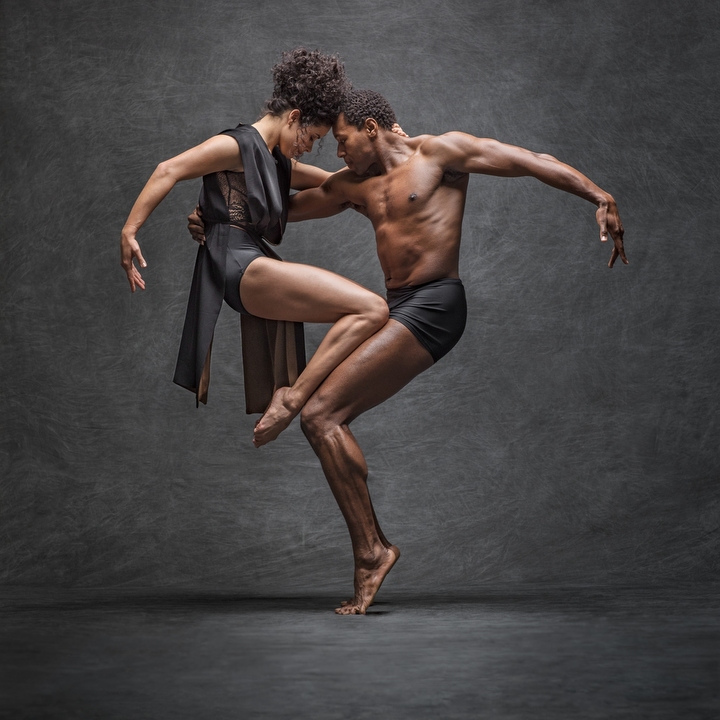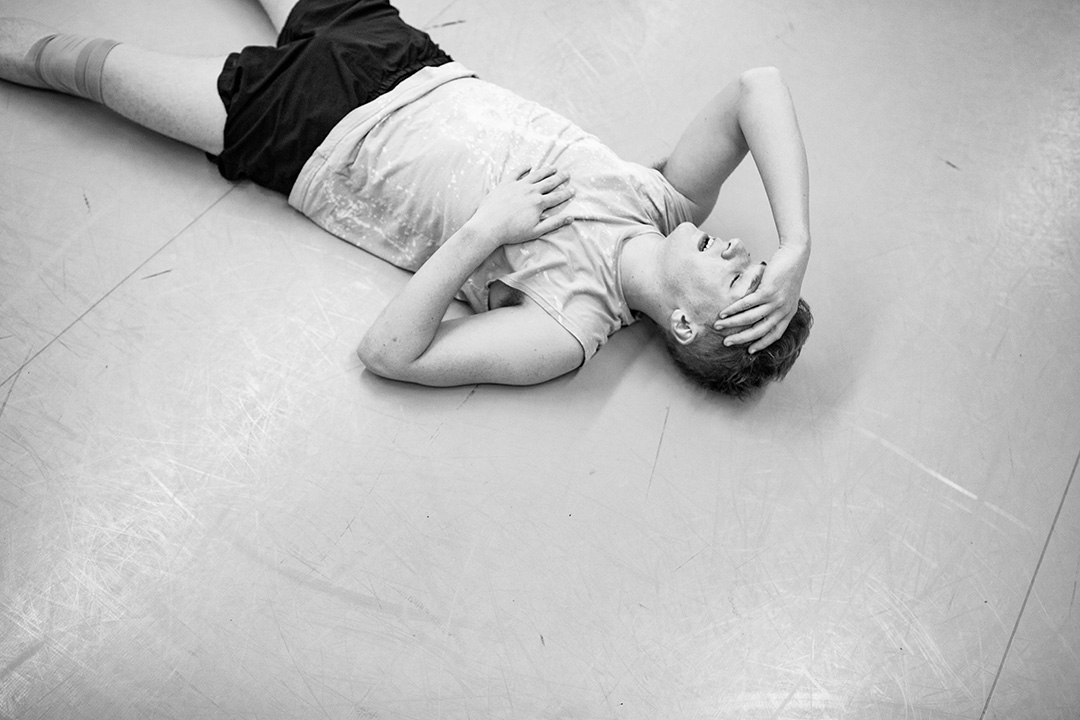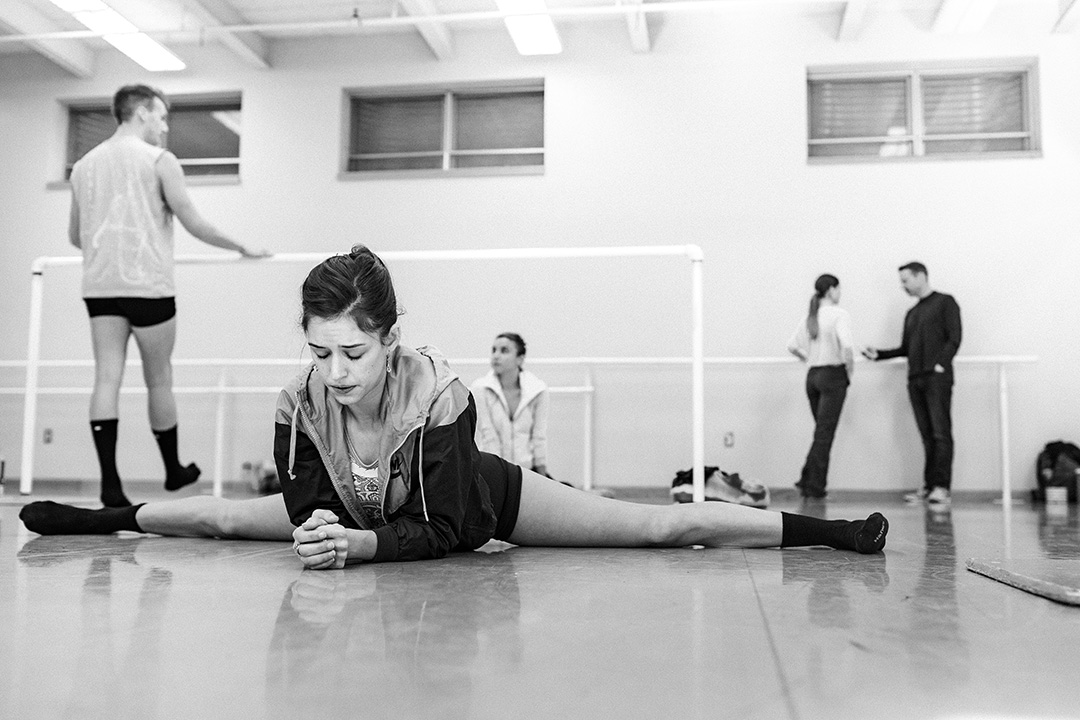
I don’t dance well. Just ask my kids. And, I must admit, I wasn’t prepared for The Dancers project at the start. But that’s what excited me more than anything.
Over the past 25 years of working as an adventure photographer and filmmaker, I have rarely set foot in a photo studio. It just wasn’t where real adventure was to be found, right? I avoided studio photography, seeking instead the ostensibly more photogenic locations of high peaks and exotic destinations.
But I have been enthralled for decades by ballet and modern dance. Each performance of the Aspen Santa Fe Ballet here in Aspen, Colorado mesmerized me — the dancers elevated grace, form and athleticism in stunning ways and the dancers’ elevation of their craft inspired me to elevate my own.
As a professional director and photographer, I believe in the importance of constant growth. Every creative needs challenges and inspirations if they are to strengthen or refine their art. Working on commercial campaigns for national brands like Wrangler and Cabela’s, I find this sort of personal reset essential. It allows me to step into a completely different role and pursue a pure aesthetic. To use a completely different set of artistic muscles, if you will.
Over the last few years, I have been lucky to be able to complete several of my own fine-art passion projects like The Farmers series, or Into The Deep, which was a collaboration with swimmer Ashley Mosher and focused on her interaction with Whalesharks. Because most of my professional work involves a rugged, outdoor aesthetic or focuses on the western lifestyle, most of my personal projects involve very different subjects, or at least a different perspective. These endeavors have allowed me to work with new inspiration, and embrace the challenge of shooting in different styles with the primary goal of creating lasting images that deeply connect with the audience on a personal level.
And so, I decided to step entirely out of my element of photographing hunters and anglers, whalesharks, climbers, farmers or crossfit athletes. I decided to step instead into a previously unexplored world: the fashion studio.
But challenge and growth walk hand in hand, and as the course of this project progressed, I found that it demanded an enormous amount of skill and persistence, the results of which produced a truly stunning collaboration of visual artists and physical artists reaching for the pinnacle of their craft.
Early Inspirations
Though I have often forgone studio work for traveling to remote locations to capture the intensity of western lifestyle and outdoor adventures like rock climbing, rodeo and ranching, that doesn’t mean I don’t appreciate work produced in studios. In fact, I was lucky to encounter some formative studio experience earlier in my career.
Ten years ago I studied with the fine-art photographer Greg Gorman and the printmaster Mac Holbert. Through their influence, I gained a greater understanding of sculpting light, shadow and form within studio stills.
I have also been a huge fan of images from Herb Ritts, Bruce Weber, and others who work in black-and-white with beautiful models and athletes. This style of imagery had been steadily percolating in my mind. For this type of content, I was really inspired by Edgar Degas’ paintings with dancers—he has an incredible way of conveying motion, light, form, and humanity.
If I could study these craftsmen and master their language of imagery, I was on the right track.
Despite the fluidity of dancers in motion on video, I decided early on that this would primarily be a stills project, as I have found myself moved more by still images of dancers than by video. Because dance involves jumping, twisting, and arcing moves, a still image can capture the athlete at a pinnacle moment of his or her expression. This moment is held in time in a captivating way. Retrospectively, I find myself returning to these images to wonder at the split-second moments.
One of the most attractive elements of the project was the powerful combination of athleticism and grace. The Aspen Santa Fe Ballet dancers are truly world-class athletes as well as performance artists. I wanted to capture the essence of their athleticism as well as their incredible skill, in a single image.
The First Challenge: Gaining Access
To pull this off, I first had to prove to the ballet that this project was one which would provide a valuable product for everyone involved. One in which everyone’s investment of time and energy paid off. At the time, I didn’t have any connections on the ‘inside’ and so had to rely on cold emails. The Ballet, I have since learned, receives countless inquiries for access to the dancers, for photos, videos, interviews, etc. But as high level athletes who must train constantly, try and fail and try again in a supportive environment of their peers, the Ballet is, rightly, a little cautious about allowing outsiders in.
To illustrate the integrity of my project, I carefully selected examples of other fine-art work which I had completed in a sort of mini-portfolio. I outlined, in detail, my desired outcomes. These would be beautiful images, valuable both for promotional purposes for the Ballet itself and powerful additions to the dancers’ own portfolios.
I patiently, and persistently waited and worked to show them the professionalism I would bring to this project.
My patience paid off. Eventually email exchanges led to an intense visioning process. Finally, we established times for me to come first to meet the dancers, and to photograph them candidly in their training and on a dress rehearsal before the actual studio-shoot.
I started with a general vision of light, form, and framing that I thought would work best for a beautiful gallery showing. However, I really have no technical knowledge of ballet or modern dance techniques. Nor did I necessarily want to to study this too heavily, as the real goal was to have a powerful co-creation with the dancers—I wanted them to bring their artistry and athleticism as they saw fit. Together we could craft an image that would be far greater than my vision alone.
So when I met with the dancers in the months leading up to the studio shoot, I shared sample images with them and I told them generally what I was hoping to achieve. But I left room for them to add themselves personally into the equation.
I told the dancers I wanted to capture something that was very special; a collection of images that would be a beautiful representation of their artistry. I mentioned that I was working with a world-class wardrobe stylist to source dramatic outfits, and I asked them to begin thinking about their best poses, etc.
When I was in the studio with them, watching them repeating physically demanding moves again and again to train their bodies into perfection, I worked hard to stay as inconspicuous as possible. I spent a lot of time on these shoots lying on the ground, or waddling on my kneepads, trying to capture storytelling moments. These were the in between moments. The moments which relied heavily on trust and patience in order to build a lasting relationship.

For this part of the project, I was firing away at 12 frames per second with the Canon 1DX Mark II camera, as I was not using any lighting. In the studio, the lighting from the window was a perfect compliment to the very real, almost gritty nature of the photographs. I also didn’t want to interrupt the dancers’ practice with strobes or other obtrusive flashes.
I will say that that the behind-the-scenes, editorial style shooting was challenging in it’s own way—mainly, trying to create truly compelling and interesting images, all while being unobtrusive to the dancers. I did not want to ask them to redo any moves, I really did not want to speak at all. I wanted to be working intimately close with them, silently, while they worked with the artistic director to prepare for their upcoming performances.
I was able to shoot the dancers and review the images that evening, then return the next day to improve on any areas where I had fallen short.
These behind the scenes images were valuable beyond the actual photograph itself. It allowed me to meet the dancers in a very casual environment, where I could establish a trusting relationship with them. I never offered direction to them; my goal was to capture unique imagery with layers of storytelling. Ultimately, I wanted them to understand the level of respect I had for them and their art, because I was going to rely heavily on that expertise when it came to the studio shooting day.
Studio Day: The Ultimate Test
I’ve written at length about how the right lighting is an essential part of successful photography. It can be one of the most fun aspects of it too, like a puzzle to solve. Even when shooting outdoor assignments, I am always captivated and propelled by lighting opportunities. I love working with challenging lighting outdoors. Over the years, I have tried to marry fine-art lighting techniques in my outdoor and adventure photo shoots. The closest I have come to shooting high fashion was during my Crossfit project, but of course, with slightly less traditional models.
What surprised me is that, in some ways, working indoors in the studio was every bit as challenging––or even more challenging––than using professional lighting outside! Everything is under a microscope in a studio shoot; there is really no excuse for having anything less than impeccable lighting. My team and I went to painstaking lengths to test setups and create just the right balance of light and shadow.
On the shoot day, my team and I had the lighting, lenses, and framing dialed in before the dancers arrived so that I could freely focus on collaborating with each dancer to find a range of breathtaking poses and expressions. But we quickly found that controlling the setup was just the beginning of the process.
In my mind, fine art imagery has to have perfect composition, perfect lighting and perfect poses. For this reason, the formal fine art photograph portion of the project proved much more challenging than the rehearsal or practice images. Add to that challenge that none of us had practiced these poses together as a team before the shoot.
Another major factor was that I could only fire one image every second or two while we waited for the strobe to recycle. So I had to try to capture the perfect moment, and I certainly didn’t always succeed! Similarly, the dancers were trying poses that were technically and athletically demanding, and they did not always achieve the perfect expression of each pose. Naturally, they tired over time.
The final demanding layer: we had only one day to do the fine-art studio shoot, no retakes! I had hired three stylist teams to come in from out of town for wardrobe, hair styling, and makeup.The dancers had blocked only that Saturday free in their schedules. All told, I had less than an hour to work with each dancer in front of the camera. You could say there was quite a bit of pressure to get it right on the shoot day.
The formal portrait shoot was an exercise in perfecting lighting, form, and composition. In contrast, the BTS images of the dancers training was really editorial in style—the goal was to capture intimate images of the dancers practicing, working themselves to exhaustion, working more, studying, socializing, etc. This quest for perfection in the portrait shoot lent itself to a sense of elevated grace and levity in every image. And the dancers and I spoke constantly through the process.
It was an intensely powerful day. I was awestruck by the passion and dedication these individuals display in their work and their life, and was so grateful to them for sharing it with me.
The post-production work on this project was equally painstaking, if not more so. The amount of time I worked in my own office with my very talented assistants, adjusting the most minute details of lighting and edging, to bring out the vibrancy and life that the dancers showed me. I wanted full-size prints, so no micro-space in the image could be overlooked. With hours and hours spent on this project, I found myself constantly returning to the inspiration, the vision that I had shared with the Ballet in the first place.
The final photographs are stunning. And I was humbled by the dancer’s reactions to them when I displayed them in a private showing for the ballet. To me, giving physical prints to my subjects completes the circle of a photographic collaboration. During the photoshoots, the athletes are giving all of themselves. In my mind, the only fair reciprocity is a print that reflects the heart and contribution each dancer offered.
For artists working in very different mediums, photography and dance, this kind of collaboration is incredibly powerful. It is inspiring to be taught to see beauty in a whole new way, and to feel as though I brought something to them which is valuable and lasting.
Below is a Behind The Scenes video for more on this project:


